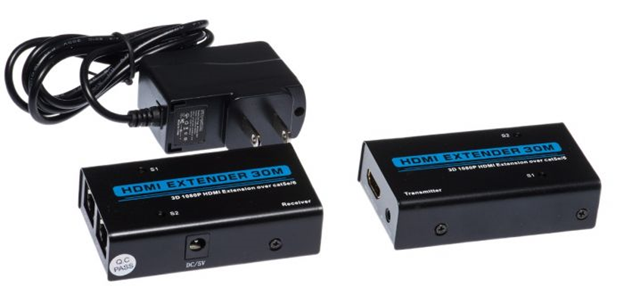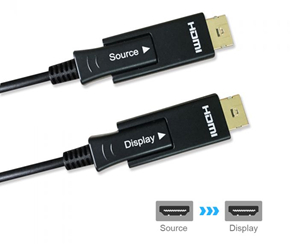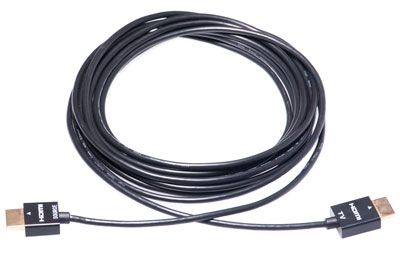You have no items in your shopping cart.
0item(s)
You have no items in your shopping cart.


HDMI is the most common audio/video cable used today. Ushered in as the new standard for the digital age, HDMI was created in a joint project by numerous electronics manufacturers who wanted to set the stage as the switch from analog to digital technology was made. The development of HDMI cables began in 2002 and was completed the following year. Each following year saw more and more HDMI-ready products enter the market. Electronics equipped with HDMI ports became readily available across the world in the coming decade, with an estimated 3 billion HDMI-ready devices made by more than 1,300 companies as of HDMI’s 10-year anniversary in 2013.
While HDMI has been around for some time now, the technology has continued to evolve since its invention. The current standard for HDMI is version 2.0, which was introduced in 2013. This was the first version of HDMI fully capable of supporting 4k signals, which have become increasingly popular for televisions, computer monitors, and projectors. While newer versions of HDMI do exist, they exceed the specs most televisions and other electronics are currently capable of supporting. Since version 2.0 cables are more cost-effective to produce, manufacturers have stuck with them as the standard for the time being. Version 2.0 will eventually become outdated but for the time being, they are considered more than adequate.
While HDMI is certainly the most popular audio/video cable for electronics, it is not the only choice available. DisplayPort is HDMI’s main competitor, also being a digital audio/video cable. While DisplayPort is a little bit better than HDMI, it was designed specifically for use with computer monitors. It is very rare to see DisplayPort on other electronics like televisions or projectors. DVI is an older video-only cable that can be digital or analog, depending on the type of DVI, but cannot perform as well as HDMI. VGA is even older and analog-only, making it the weakest video cable still in use today.

From left to right: HDMI (Type A), Mini HDMI (Type C), and Micro HDMI (Type D)
When someone says “HDMI”, they are usually referring to a full-size HDMI cable. This is also called HDMI Type A. Most devices that use HDMI connections are big enough to sport at least one of these ports, but what about smaller electronics? These days, many people want to be able to connect handheld devices like tablets and smartphones to TVs. When using an online streaming service or even doing something as simple as looking through pictures, it can be nice to put those images on a bigger screen. Mini HDMI (also called HDMI Type C) and Micro HDMI (HDMI Type D) ports are used on smaller devices where there is not enough room for a standard HDMI port.
The designers of HDMI also made sure that HDMI would remain compatible with other types of audio/video cables. Other digital video cable formats are all compatible with HDMI, either as a pre-made cable or by using an adapter to change a standard HDMI cable to whichever other format is needed. It is possible to use HDMI with analog signals as well, but this requires a converter. Converters usually need a secondary power cord to plug into an outlet instead of using a single cable like digital-only setups.

While HDMI is a fantastic all-around cable, it is not without its limitations. The main drawback is distance. A standard HDMI cable has a maximum distance of 60 feet. Some HDMI cables may have issues at shorter lengths as well, depending on the quality of the cable. There are two main ways to resolve this issue. The first is to use an extender. Extenders come in pairs and allow an Ethernet or coax cable to be used as an extension cord for the HDMI. These can allow HDMI to run up to almost 2,300 feet (depending on the model of extender used).

The other method is to use a fiber optic HDMI cable. Most HDMI cables are made with copper and use electricity to send signals. Fiber cables use light (lasers) instead, which have a much longer distance limit. This technology does make the cables directional (one-way), so take care not to install one backward by mistake. This breed of HDMI can support distances of up to 200 feet and have a built-in Micro HDMI connection for use with handheld electronics.

The other major factor to consider is the speed of an HDMI cable. If the cost of a new television has four digits, a standard 2.0 HDMI cable may not be up to snuff. In that instance, a RedMere HDMI cable is a great solution. This type of HDMI is built with special computer chips that boost functionality and allow the cables to be made with less metal, which provides better flexibility. Like fiber optic HDMI cables, RedMere cables are directional, so it is possible to accidentally install them backward. Always make sure to check the marking on the ends of a RedMere cable before installation.
EagleG offers a wide variety of HDMI products. This includes regular HDMI cables, cables that go to other formats, adapters, converters, and more. No matter what type of HDMI cable you are looking for, EagleG has the connections to get you connected.
Have questions about HDMI or any of our other products? Our Sales team can be reached at (800) 571-8306 or sales@eagleg.com
Newer Post →